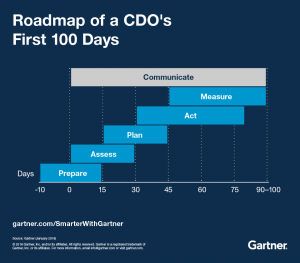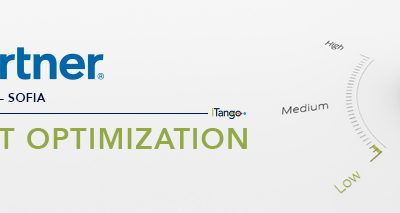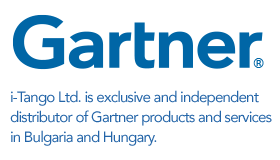Gartner’s roadmap includes steps for CDOs to succeed in their new role.
Contributor: Rob van der Meulen
By 2019, 90 percent of large organizations will have a chief data officer (CDO), yet only half will be hailed a success. Any new job is challenging, especially when it’s a new role in the organization. So how to begin?
The first 100 days constitute a “honeymoon” period. Within this brief period the CDO must establish themselves and create perceptions that others will associate with their subsequent actions.
Debra Logan, vice president and Gartner Fellow, said that preparing, and communicating, a clearly phased plan is critical. “You may be the first CDO in your company, and you’ll need to work hard to give the role credibility while coaching business leaders on how data can support their goals,” Ms. Logan said.
Gartner breaks down the CDO’s objectives into a 100 day roadmap (see Figure 1). Each phase includes critical target outcomes, actions and resources, as well as some optional ideas to consider as time and resources allow.
Prepare
Set up meetings with your team and key business and IT leaders before you join, and prepare a set of introductory materials about your experience. If you are a veteran in the business and have moved into the CDO role, make sure you briefly review your experience. Demonstrating that you understand ”how things work around here” is crucial.
Assess
Use face-to-face meetings to build a strong understanding of the business and rapport with key stakeholders. Devote at least 50 percent of your time to meeting these stakeholders to explain the CDO role, and how it will help them meet their business-critical objectives.
A list of no more than five thoughtful questions will be more instructive than trying to cover everything. Pay close attention to chronic pain points and previous failures and actively solicit feedback on perceptions of the CDO and other data-based roles. Get a sense for how the CIO and IT organization are regarded in the business.
Plan
The plan phase turns what you’ve learned into a blueprint for action. Share a vision with your team, line managers and the original business stakeholders you interviewed. Support this with an assessment of how the organization compares with your vision and outline how you will close the gap. Remember to phrase these objectives in terms of the business key performance indicators (KPIs) that are important to the goals set by executives and managers.
Act
Meet with your operational teams to define their scope of operation and consider performance metrics. Ask what you can do to help them succeed.
Conduct a senior management status meeting and develop a quarterly schedule. These will be some of the most valuable meetings you have. Keep the agenda simple:
- What did you say you were going to do during this period?
- What did you do?
- What was the business value?
- What business value would the executive team like you to deliver during the next period?
The executive team will determine how to integrate your needs into their strategy and must make clear their view on what constitutes success. This will give you clear objectives and structure for future meetings.
Measure
You must articulate the business value of your project teams’ efforts, so regular progress report meetings should focus on the information most relevant to business and finance leaders.
Gartner clients can read more in the report “The Chief Data Officer’s First 100 Days”. CDOs should attend the dedicated CDO program at the Gartner Enterprise Information & Master Data Management Summits taking place in London, U.K. and Grapevine, Texas. You can follow news and updates from the events on Twitter using #GartnerEIM.
For more articles visit Smarter With Gartner website.











